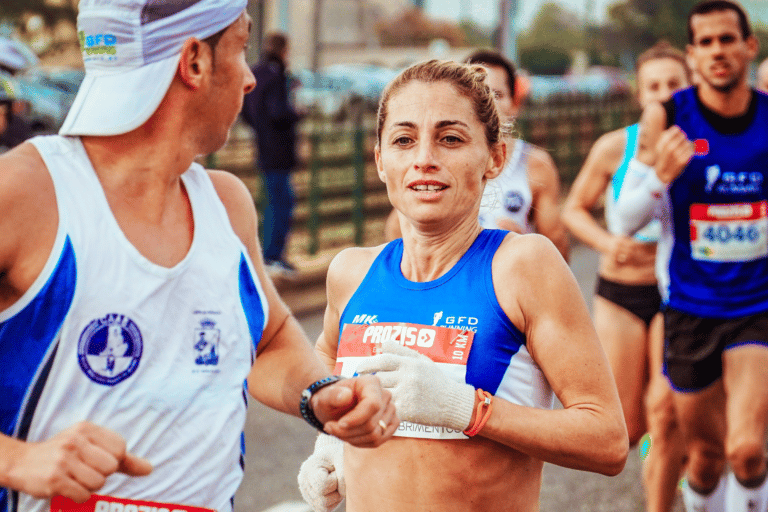Why Does Running Burn So Few Calories? (With Some Quick Averages)
Have you been running for weeks, but don’t seem to be losing the weight you feel you ought to be losing? If you find yourself frustrated by what seems to be minimal returns on your time spent hitting the pavement, you might be wondering, Why does running burn so few calories?
Despite the common myth that running doesn’t help with weight loss, it actually burns calories more efficiently than just about any common exercise movement. However, the exact amount of calories you burn will depend upon your size, pace, running intensity, and exercise duration.
To learn why running can be such an efficient way to burn calories, continue reading below.
Why don’t I burn a lot of calories when I run?
Though muscle-heads in the gym will have you believe that a few minutes of walking on an inclined treadmill is all you need to incorporate into your workout for cardio, running has many benefits for cardiovascular fitness and weight loss.
Since running is one of the most efficient exercises for burning calories, you may be wondering why you don’t seem to be losing weight, despite your running habit. The following factors may be inhibiting your caloric burn rate while running:
- Low initial body weight
- Slow Pace
- Low Intensity
- Short Duration of workout
Let’s dive into each of these to find out what’s keeping you from burning those calories.
Low initial body weight
Since running is a bodyweight exercise, the amount of resistance you carry will be your own weight. The more you weigh, the more energy is required to move your body. Therefore, more calories will typically be burned quickly by heavier people than by lighter people.
This is called your metabolic rate. However, metabolic rate is affected greatly by the amount of muscle tissue a person has.
According to metabolic rate studies, larger, more muscular people will burn more calories than a larger person with more fatty tissue. Thus a general rule, it is good to remember that larger people burn more calories than smaller people, and that muscle burns more calories than fat.
This also means that smaller people with little muscle mass will likely have a difficult time burning calories.
Slow pace
The burning of calories is accomplished by moving your body.
The more your body moves, and the quicker you move, the more calories you burn. A slow running pace will require much longer to burn the same amount of calories as someone running the same distance at a higher rate of speed.
It’s simple mathematics.
Low intensity
If you find yourself failing to burn the desired amount of calories in your run, you may need to introduce higher-intensity movements.
Performing a workout at a higher intensity will tax the body in ways that a longer, sustained workout may not.
This may mean running up large hills, running at high speeds for long amounts of time, introducing sprint intervals into your run, etc. Incorporating these types of high-intensity movements into your run can help increase the caloric burns you experience.
Short duration of workout
If you find yourself burning fewer calories than you thought while running, the simplest solution would be to try increasing the duration of your runs.
The longer you run, the more calories you will burn. With that being said, running for longer periods of time will always be a way to increase the overall number of calories burned.
If you have the time and energy to do this, it might be the strategy for you.
How many calories does a 30-minute run burn?
The number of calories you burn during any run will depend entirely on your size, pace, intensity, and duration.
While it’s hard to say exactly how many calories you will burn during a 30-minute run without knowing any of the other related factors, we can provide an estimate based on US average sizes for men and women.
- Men – An average-sized U.S. male is about 5’9” and weighs approximately 197 lbs. If a man this size were to run for 30 minutes at a 10-minute-per-mile pace, he would burn around 460 calories.
- Women – The average-sized U.S. female is about 5’4” and weighs approximately 170 lbs. If a woman this size were to run for 30 minutes at a 10-minute-per-mile pace, she would burn around 397 calories.
Given that the daily recommended caloric intake for men is 2,500 and around 2,000 for women, a 30-minute run per day should accelerate caloric expenditure by 15-25%.
Running for 30 minutes can be a great way to increase your chances of obtaining a daily caloric deficit, but keep in mind that an otherwise sedentary lifestyle will probably not allow you to burn the number of calories necessary to really experience consistent weight loss.
How many calories can I burn after running every day?
Running every day may not be the best idea for your overall health, due to the strain it places on your muscles and joints. For optimal performance and results, make sure to build in some rest days to your running routine.
With that being said, if you plan to burn a specific amount of calories in a given period, you might wish to run every day for a set number of days. As stated before, running is one of the most efficient exercises for burning calories.
Of course, we’ve also already mentioned that the amount of calories you burn depends on a number of factors. However, without getting into those specific factors, let’s look at how many calories an average-sized adult male and female will burn if they choose to run 2 miles per day for various intervals: 1 week, 1 month, 1 year.
Sticking with our 10-minute pace from above, the average-sized adult male would burn 306 calories per day, 2,142 per week, 8,568 per month, and 102,816 per year approximately.
For the average-sized US woman at the same pace, the numbers are a bit smaller at 264 per day, 1,848 per week, 7,392 per month, and 88,704 approximate calories burned per year.
As you can see, these numbers begin to lose meaning as the time increments get larger, but for reference, that’s the equivalent of canceling out 41 days of eating the suggested daily caloric intake for men per year, and 44 days for women! If you ran every day and ate the suggested amount of calories, you ought to lose quite a bit of weight in a year.
However, the drawbacks to running every day, mentioned at the beginning of this section, are too serious to overlook. Running every single day is not a suggested weight loss strategy, nor is it safe to do so.
Does running faster burn more calories?
If you’re looking to increase your calorie burns while running, consider increasing your pace.
Running faster increases the amount of energy required to complete your run. Since the expending of energy requires the burning of additional calories, you are more likely to burn more calories if the pace and intensity of your run increase.
If you’re looking for a more balanced physique, you may even want to work in some sprint work as well. This can help build fast twitch muscle fibers that would not otherwise be developed with a normal long-distance running routine. In addition to muscle development, this type of high-intensity exercise can increase the rate at which you burn calories as mentioned above.
Do “fitter” runners burn fewer calories?
We mentioned earlier than larger runners burn more calories over the course of the same run. Why is that?
Fitter runners do burn fewer calories when running because they are able to complete the exercise with less expended energy.
Of course, the true answer to this question depends on what exactly you mean by “fitter” and “less.” Less than who? Remembering the earlier discussion on metabolic rate, it’s important to remember that muscle burns more calories than fat.
If by “fitter” you mean more muscle, then it’s possible that this extremely muscular runner could burn more than a flabbier competitor. That being said, if a runner already possesses a healthy body composition and exhibits excellent cardiovascular endurance, they will not require as much energy to perform the task as an overweight or out-of-shape runner may require.
This should lead to a decrease in caloric burning in most cases.






